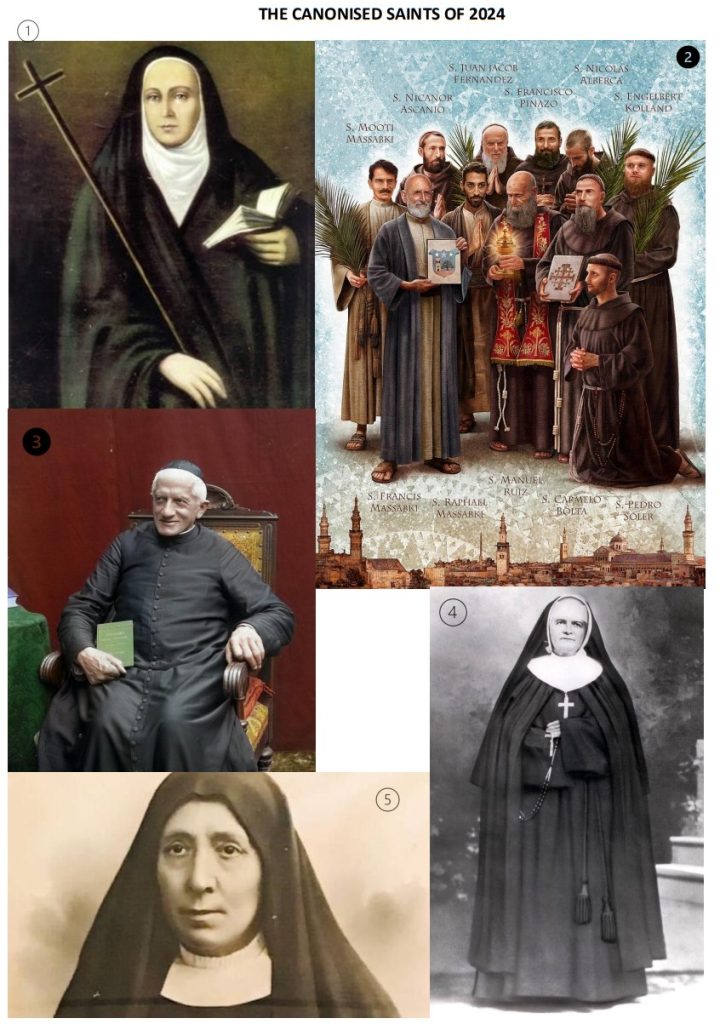1. María Antonia de Paz y Figueroa b. 1730 in Argentina. She came from a family of rulers and conquerors, but at the age of 15 wanted to give her life to God and live in a community of women. She was supported by a Jesuit priest, but when the Jesuits were expelled from Argentina in 1767 she upheld The Spiritual Exercises of St Ignatius of Loyola by leading retreats and organising spiritual direction. Her writings and letters became hugely influential across the world, and were translated into French, English and German. She died in 1799, aged 69 years and was buried in Buenos Aires.
2. Eleven martyrs of Damascus who were killed while praying inside a Franciscan church in Damascus, Syria, on the night of the 9th July 1860. Three were brothers (Massabki family) from Damascus, and the other eight were Franciscans, seven from Spain and one from Austria. Two of the Massabki brothers were married and had children, and one of them was killed in front of two of his children. All of them were killed by Druze Muslims. The youngest was aged 30 and the oldest 57 years.
3. Giuseppe Allamano b.1851 in Asti, Piedmont, Italy. One of five children, his father died when he was aged just 3 years old. He was ordained a priest in 1873, and in 1880 he became the rector of the Shrine of Our Lady of Consolation in Turin. Recovering from a serious illness, he vowed to found a missionary society, and so began the Consolata Missionaries in 1901 and their first mission was to Kenya. He proposed to Pope Pius X that there should be an annual mission day to awaken vocations to the missions, but his request was put on hold when World War I broke out. Pope Pius XI then instituted the first World Mission Day in 1927, the year after Giuseppe Allamano died. The Consolata Fathers and Sisters promoted their founder’s intercession, and the healing of a man attacked by a jaguar in the Amazon rainforest was the miracle attributed to his intercession needed for his canonisation.
4. Marie-Léonie Paradis b.1840 Quebec, Canada. One of six children, only three of which survived till adulthood. Despite her poor health, she joined the Congregation of the Marianites in Montreal, and she taught for several years. In 1862 she was sent to St Vincent de Paul church in Manhattan, New York City, a parish for French-speakers, and she worked in the orphanage there. Eight years later she was sent to Indiana where she taught, and then returned to Canada to be the novice mistress in a college in New Brunswick. She founded another congregation, the Little Sisters of the Holy Family, despite dying of cancer. The Rule was given official permission to be published on the morning of the day of her death in 1912. She is only the third Canadian-born person to be canonised.
5. Elena Guerra b. 1835 Lucca, Tuscany, Italy. One of six children to a wealthy family. As a young girl cholera struck her hometown, and she helped with the Vincentians to care for the poor and sick. When she was 22 years of age, she developed an illness that consumed her for the next seven years when she was unable to leave home. During that time, she studied French, music and art, but also the lives and works of the Church Fathers. On her recovery, she established an association dedicated to the education of girls. In 1885, she wrote to Pope Leo XIII asking him to rekindle devotion to the Holy Spirit. The Pope responded positively, and this encouraged Elena to write 13 more letters to the Pope over a period of years. In 1897, Pope Leo issued an encyclical on the Holy Spirit in which he established the Novena to the Holy Spirit between Ascension Thursday and Pentecost Sunday. Pope Leo gave her a private audience and encouraged the work of her Congregation and renamed it as “The Oblates of the Holy Spirit.” She died in 1914, aged 78. Pope John XXIII beatified her in 1959 and called her “a modern-day apostle of the Holy Spirit.”

